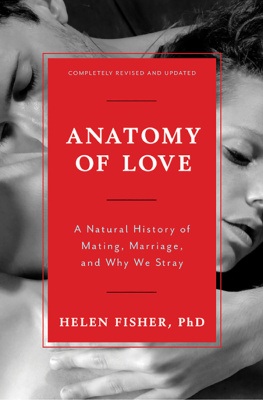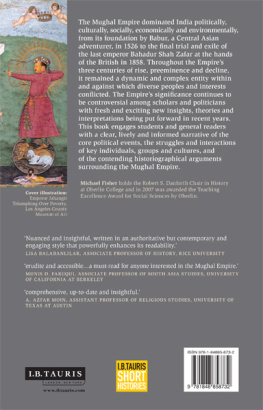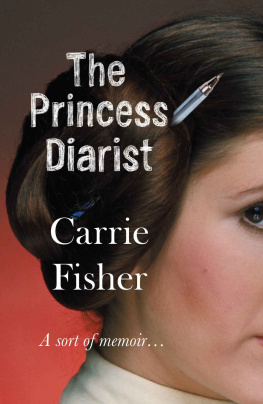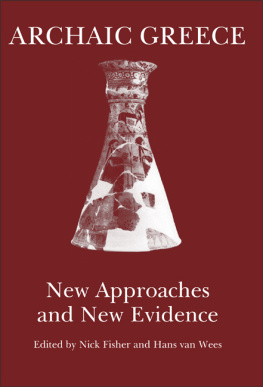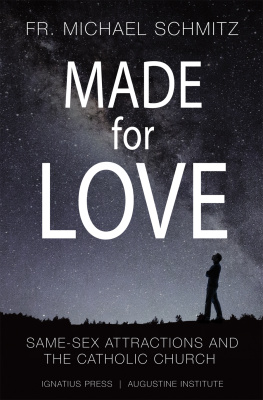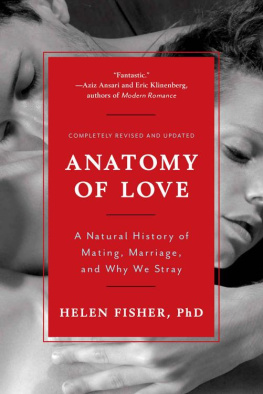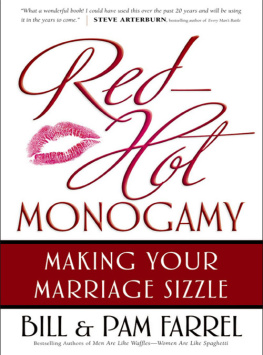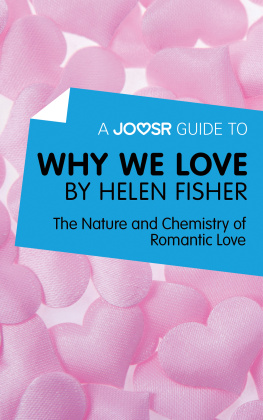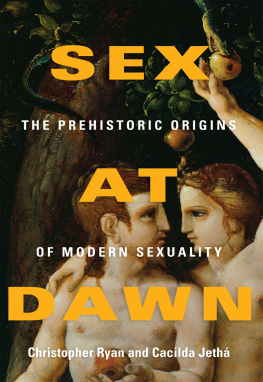
Anatomy
of
Love
A Natural History of Mating,
Marriage, and Why We Stray
COMPLETELY REVISED AND UPDATED
Helen Fisher, PhD

W. W. Norton & Company
Independent Publishers Since 1923
New York London
ALSO BY HELEN FISHER
Why Him? Why Her? How to Find and Keep Lasting Love
Why We Love: The Nature and Chemistry of Romantic Love
The First Sex: The Natural Talents of Women and How They Are Changing the World
The Sex Contract: The Evolution of Human Behavior
ANATOMY OF LOVE
Copyright 2016, 1992 by Helen E. Fisher
Previous edition published under the title ANATOMY OF LOVE: The Natural
History of Monogamy, Adultery, and Divorce
All rights reserved
For information about permission to reproduce selections from this book,
write to Permissions, W. W. Norton & Company, Inc.,
500 Fifth Avenue, New York, NY 10110
For information about special discounts for bulk purchases, please contact
W. W. Norton Special Sales at specialsales@wwnorton.com or 800-233-4830
Book design by Dana Sloan
Production manager: Louise Mattarelliano
ISBN: 978-0-393-28522-2
ISBN: 978-0-393-35091-3 (e-book)
W. W. Norton & Company, Inc.
500 Fifth Avenue, New York, N.Y. 10110
www.wwnorton.com
W. W. Norton & Company Ltd.
Castle House, 75/76 Wells Street, London W1T 3QT
FOR LOVERS EVERYWHERE
And in memory of Ray Carroll
CONTENTS
T hank you, Hillary DelPrete, for your superb research help on this book. Thank you, John Gurche, for your fascinating depiction of an ancestral couple. I am indebted to Mandy Ginsberg, Amy Canaday, and everyone else at Match.com for providing me with my data on singles in America, and to Justin Garcia for helping me share this material with a wide academic and lay audience. I am grateful to Amy Cherry at W. W. Norton, who invited me to do this rewrite, to Allegra Huston for your copyediting, to Remy Cawley and all the Norton staff for your efforts on behalf of this book, and to Amanda Urban, my agent, for your guidance. Thank you Lucy Brown for our collaboration on many intellectual projects and for your continual work on our website (TheAnatomyOfLove.com), which features some of the ideas in this book. Thank you, Lee Silver, for doing complex mathematical analyses of my personality data presented here. Thank you to my friend Fletcher Hodges for your wisdom and encouragement; to my friends at the Royce Carlton lecture agency and the TED conferences for helping me broadcast some of these ideas; to Dave Labno for working with me to apply these data on personality to business consulting; and to Gerry Ohrstrom, Thomas Campbell Jackson, Elizabeth Eiss, and Dyan Daley for enabling these ideas to reach broader business and medical communities. Thank you, Christian Frei, for your documentary Sleepless in New York, featuring some of the ideas in this book. I thank Lorna, Audrey, and the rest of my family and friends for your patience and good humor during this odyssey. Last, I deeply thank Ray Carroll, my deceased friend, for all he did for the original version of Anatomy of Love.
Journalist: Why do you only write about relationships?
Nora Ephron:Is there something else?
I was recently traveling in the highlands of New Guinea in the back of a pickup truck, talking with a man who had three wives. I asked him how many wives he would like to have. There was a pause as he rubbed his chin. I wondered: Would he say five? Ten? Twenty-five wives? He leaned toward me and whispered: None.
We are a pair-bonding species. Some 85% of cultures permit a man to have several wives, but few men actually build a harem. A man has to have a lot of goats, cows, land, money, or other impressive resources to get several women to share his wedding bed. Even then, having more than one wife can be a toothache. Co-wives fight; sometimes they even poison one anothers children. We are built to rear our babies as a team of twowith a lot of helpers near the nest.
This book is the story of that monumental human passion: to love. As well as all of the spinoffs of our basic human reproductive strategy: how we court; who we choose; how we bond; why some are adulterous and some divorce; how the drive to love evolved; why we have teenagers and vast networks of kin to rear our young; why a man cant be more like a woman and vice versa; how sex and romance drastically altered with the invention of the plow; and, in the last chapter, a new look at future sex.
When W. W. Norton invited me to do a second edition of this book, I gaily said yes, thinking this was a privilege and an easy job. The first version had taken me ten years to write; I thought this revision might take ten days. Then I read the bookand swiftly realized that I had to update almost all of it.
So I have now added a great deal of data and ideas, including data on all of our brain-scanning experiments on romantic love, rejection in love, and long-term love; my new data on the biology of personality and why you fall in love with one person rather than another; new information on adultery, love addiction, sexual selection, and mate choice; the newest statistics on worldwide patterns of divorce; my theory on the development of morality across the life course; my hypothesis about our modern dating habitswhat I call slow love,; and a wealth of new data on future sex, collected in collaboration with Match.com. I also added references for my additions (and retained most of the original references) and two of my questionnaires as additional appendices.
Journalist David Gergen once called me Americas last optimist. There is much to cry about, but there is also much to celebrateincluding our inexhaustible human drive to love. Technology is changing how we court. But it cant change love. Romantic love and attachment emanate from the most primitive regions of the brain, near those that orchestrate thirst and hunger. And as Plato aptly wrote in The Symposium: The God of love lives in a state of need. Love is a need, a craving, a drive to seek lifes greatest prize: a mating partner. We are born to love. Indeed, if we survive as a species, we will still fall in love and form pair-bonds a million years from now.
This book traces the trajectory of this indestructible human passion. And it ends on a high note. I firmly believe that if there ever was a time in human evolution when we have the opportunity to make happy partnerships, that time is now.
Heres to love,
Helen Fisher
Moved by the force of love,
fragments of the world seek out one another
so that a world may be.
PIERRE TEILHARD DE CHARDIN
I n an apocryphal story, a colleague once turned to the great British geneticist J. B. S. Haldane and said, Tell me, Mr. Haldane, knowing what you do about nature, what can you tell me about God? Haldane replied, He has an inordinate fondness for beetles. Indeed, the world contains over 300,000 species of beetles.
I would add that God loves the human mating game, for no other aspect of our behavior is so complex, so subtle, or so pervasive. And although these sexual strategies differ from one individual to the next, the essential choreography of human courtship, romance, love, and marriage has myriad designs that seem etched into the human psyche, the product of time, selection, and evolution.
They begin the moment men and women get within courting rangewith the way we flirt.
Body Talk
Irenus Eibl-Eibesfeldt, a German ethologist,secret lens so that when he directed the camera straight ahead, he was actually taking pictures to the side. This way he could focus on local sights and catch on film the unstaged facial expressions of people near him. In his travels to Samoa, Papua, France, Japan, Africa, and Amazonia, he recorded numerous flirting sequences. Then, back in his laboratory at the Max Planck Institute for Behavioral Physiology, near Munich, Germany, he carefully examined each courting episode, frame by frame.
Next page
